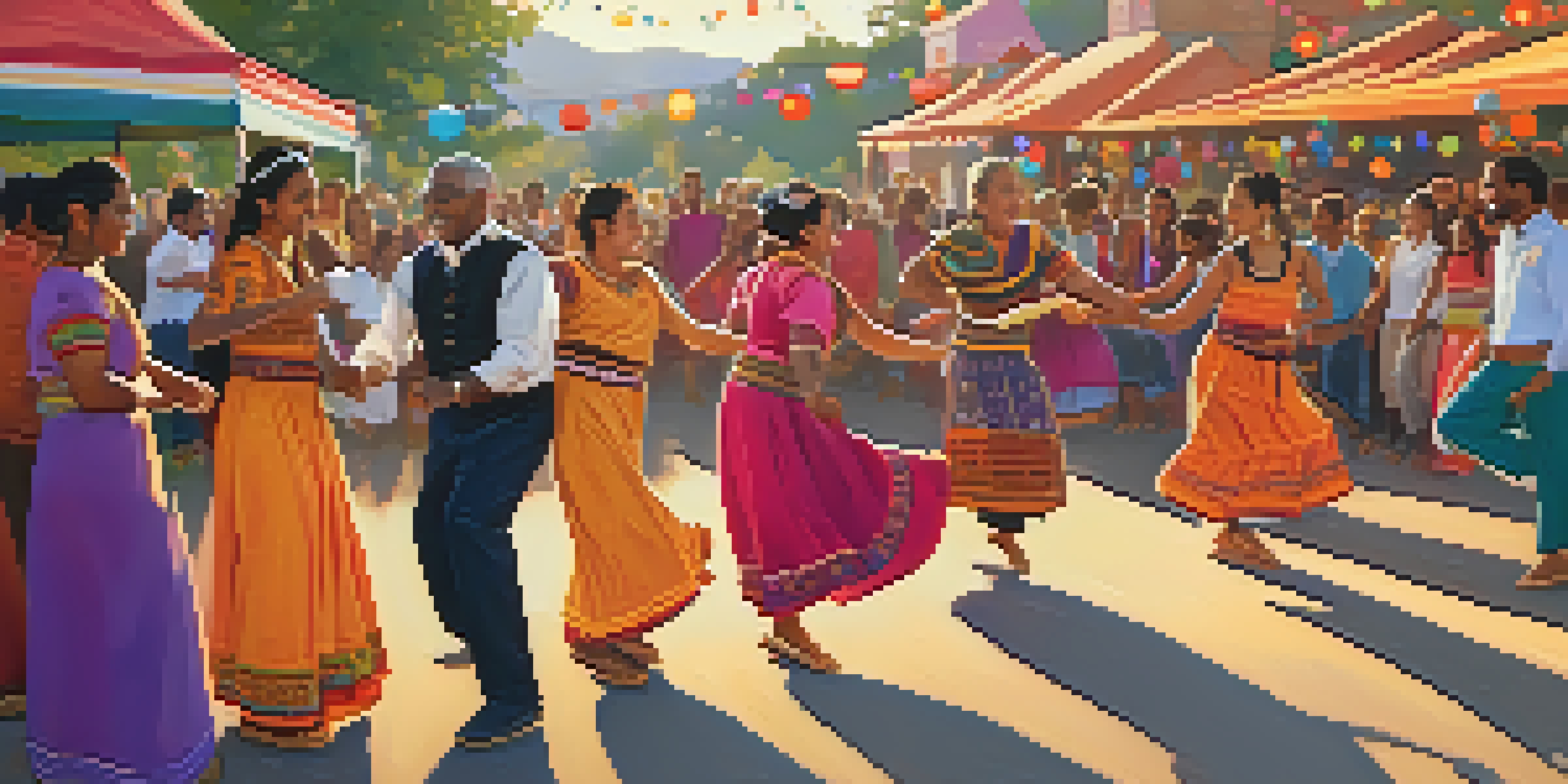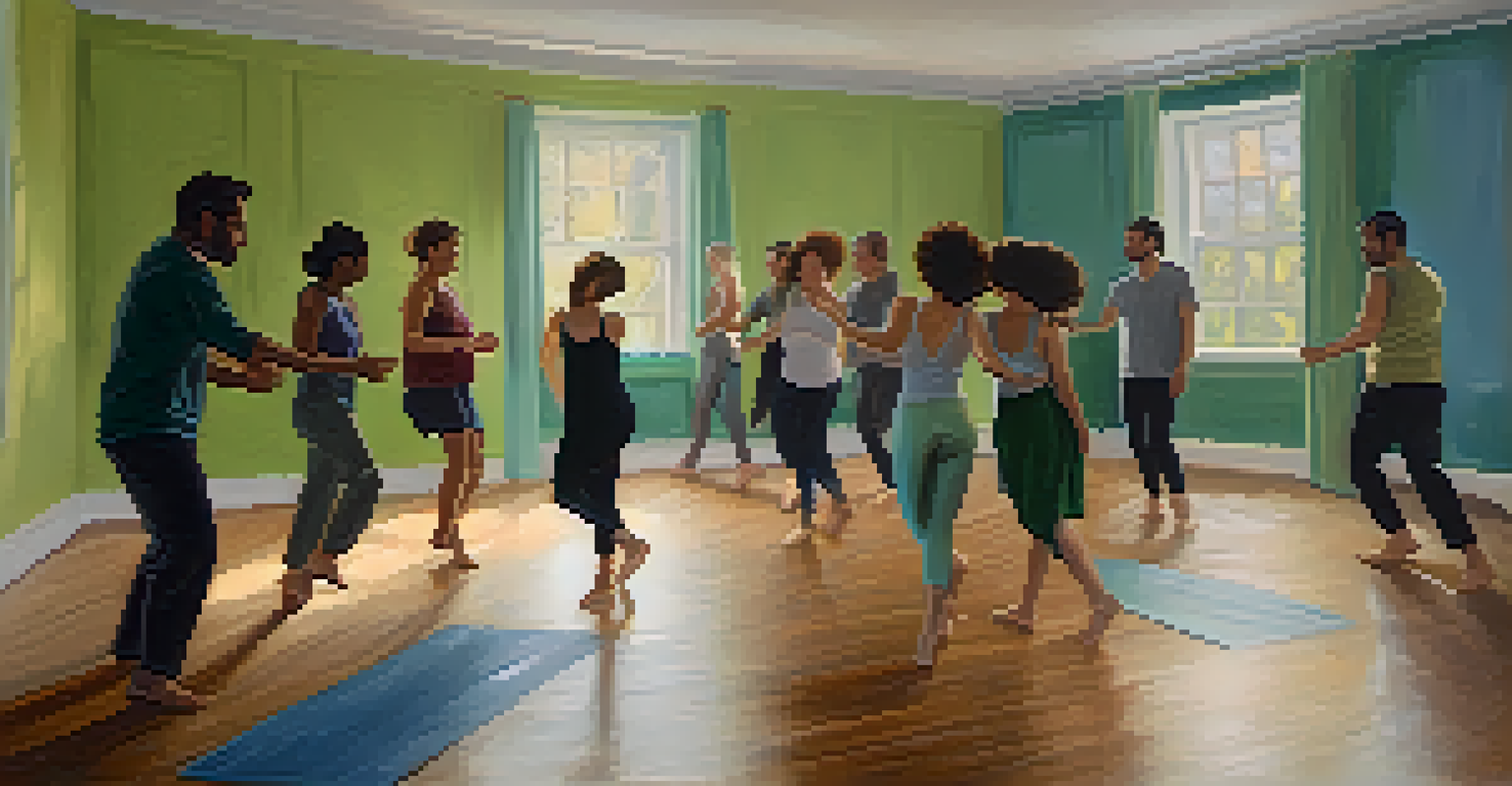The Impact of Dance on Building Social Connections

Dance as a Universal Language of Connection
Dance transcends verbal communication, connecting people from diverse backgrounds. It's a vibrant expression of culture and emotion that can bring individuals together, fostering a sense of belonging. Whether it's a salsa class or a traditional folk dance, the shared experience creates bonds that are often deeper than words.
Dance is the hidden language of the soul.
Think about a group of strangers at a wedding, hesitant to mingle. Once the music starts and they hit the dance floor, the awkwardness fades away. Laughter and movement replace shy glances, illustrating how the rhythm of dance can dissolve barriers and spark connections.
In essence, dance acts as a bridge, allowing people to connect on a fundamental human level. This universal language encourages openness and invites individuals to share their stories, creating a tapestry of relationships that enriches our social experiences.
Building Community Through Group Dance Activities
Group dance activities, such as dance classes or flash mobs, serve as excellent platforms for forming social connections. When participants come together to learn choreography or enjoy a dance, they create a shared goal that encourages teamwork and camaraderie. These communal experiences help individuals feel more integrated into their community.

Take, for example, community dance festivals where people gather to celebrate movement. Participants not only engage in dance but also interact with one another, leading to friendships that extend beyond the dance floor. The collective energy of these events can foster a sense of unity and belonging.
Dance Connects Diverse Communities
Dance transcends barriers, fostering connections among individuals from various backgrounds through shared experiences.
Ultimately, group dance activities are more than just fun; they are vital in building a supportive community. By participating in these events, individuals not only improve their dance skills but also cultivate lasting relationships, reinforcing the importance of connection in our lives.
The Role of Dance in Breaking Social Barriers
Dance has the remarkable ability to break down social barriers, creating an inclusive environment for all. It doesn’t matter your age, background, or skill level; when the music plays, everyone is invited to participate. This inclusivity can lead to diverse friendships that might not have formed otherwise.
Dancing is like dreaming with your feet!
Consider a dance program aimed at integrating people with disabilities into mainstream dance classes. These initiatives not only empower participants but also educate those around them, fostering understanding and empathy. Through dance, individuals learn to appreciate each other's differences, building a more cohesive community.
Thus, dance serves as a powerful tool for social change, promoting acceptance and understanding. As individuals engage in movement together, they learn to celebrate their uniqueness while recognizing the common threads that unite them.
Dance: A Catalyst for Emotional Support and Connection
Beyond physical movement, dance is a profound way to express and process emotions. Many people find solace in dance during difficult times, and doing so in a group can enhance feelings of support and solidarity. When individuals share their stories through movement, they invite others to connect with their experiences.
In dance therapy settings, participants often report feeling more understood and supported by their peers. The act of dancing together can foster a sense of community that encourages emotional vulnerability, creating safe spaces where people feel free to express themselves.
Group Dance Builds Strong Bonds
Participating in group dance activities cultivates teamwork and camaraderie, enhancing social integration within communities.
Ultimately, dance not only offers a physical outlet for emotions but also cultivates deep emotional connections. By sharing these moments, individuals form bonds that are rooted in empathy and understanding, enhancing their overall well-being.
The Impact of Cultural Dance on Social Unity
Cultural dance forms play a crucial role in preserving heritage while also fostering social connections. Participating in traditional dances allows individuals to connect with their cultural roots and share their history with others. These shared experiences can create a sense of pride and belonging among participants.
For instance, community events that celebrate cultural dances often invite diverse groups to participate. Each dance tells a story, and as individuals come together to learn and perform these dances, they create a narrative of unity and respect for one another’s cultures.
Thus, cultural dance serves as a powerful medium for social unity. By engaging in these traditional practices, individuals not only connect with their heritage but also foster mutual respect and understanding within their community.
Dance as a Tool for Personal Growth and Connection
Participating in dance can significantly contribute to personal growth, which in turn enhances social connections. As individuals learn new dance styles or techniques, they build confidence and self-esteem. This newfound self-assurance can make it easier to initiate conversations and form friendships.
For many, joining a dance class is a brave step outside their comfort zone. This shared experience of facing challenges together strengthens the bonds between participants. As they encourage one another, they cultivate a supportive network that transcends the dance floor.
Cultural Dance Fosters Unity
Engaging in cultural dance allows individuals to connect with their heritage while promoting mutual respect and understanding.
Ultimately, dance empowers individuals not just as dancers but as confident social beings. By embracing personal growth through movement, people create lasting connections with others who share their journey.
The Online Dance Community: Connecting in the Digital Age
In today's digital world, online dance communities have emerged as powerful platforms for connection. Social media and video-sharing platforms allow dance enthusiasts to share their passion, regardless of geographical barriers. This virtual space fosters relationships among individuals who might never meet in person.
Consider the rise of TikTok dance challenges that unite users globally. Participants not only learn popular moves but also connect with others who share their interests. These interactions often lead to friendships that extend beyond the screen, illustrating the power of dance in creating community in the digital age.

Thus, online dance communities play a vital role in enhancing social connections. By tapping into the global love for dance, individuals can find camaraderie and support, proving that distance doesn't diminish the power of movement to unite us.
Conclusion: The Transformative Power of Dance in Social Connections
In summary, dance is much more than a form of artistic expression; it is a powerful tool for building social connections. From breaking down barriers to fostering community and emotional support, the impact of dance is profound. It encourages individuals to come together, share experiences, and create lasting bonds.
As we explore the various ways dance influences our social lives, we see that it offers opportunities for personal growth and cultural understanding. Whether through group activities, cultural dances, or online communities, the act of dancing brings people together in meaningful ways.
Ultimately, embracing dance in our lives can lead to a richer, more connected existence. So, whether you're a seasoned dancer or a curious beginner, consider stepping onto the dance floor and opening yourself to the connections that await.